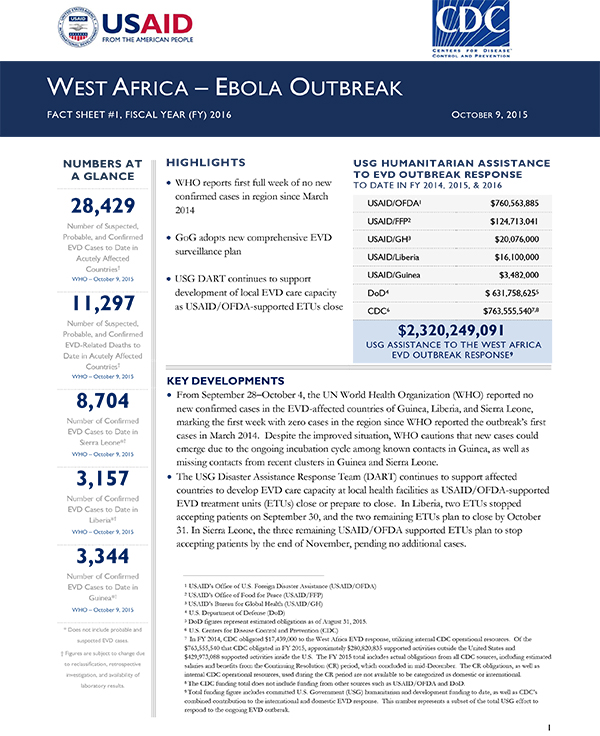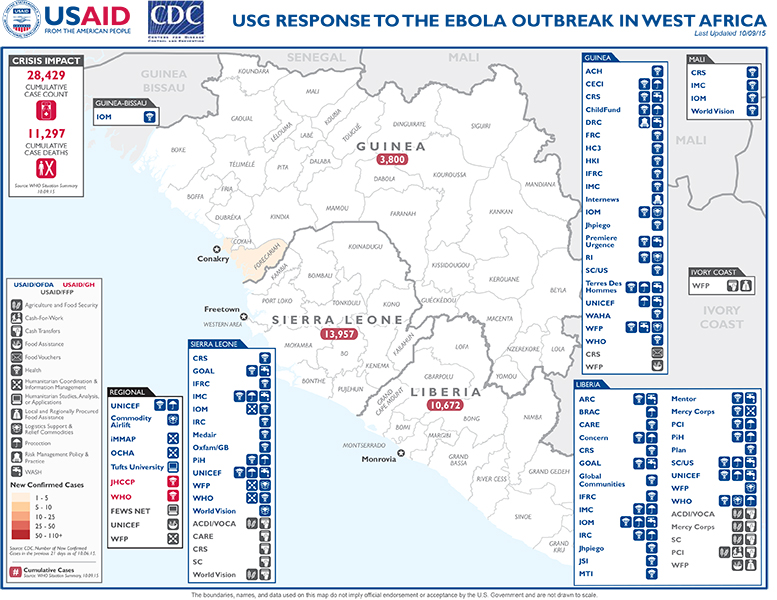Speeches Shim
October 9, 2015
HIGHLIGHTS
Ebola Response
Visit our main West Africa Ebola Outbreak page to learn more about how we're responding to the West Africa Ebola outbreak, and what you can do to help.
- WHO reports first full week of no new confirmed cases in region since March 2014
- GoG adopts new comprehensive EVD surveillance plan
- USG DART continues to support development of local EVD care capacity as USAID/OFDA-supported ETUs close
KEY DEVELOPMENTS
- From September 28–October 4, the UN World Health Organization (WHO) reported no new confirmed cases in the EVD-affected countries of Guinea, Liberia, and Sierra Leone, marking the first week with zero cases in the region since WHO reported the outbreak’s first cases in March 2014. Despite the improved situation, WHO cautions that new cases could emerge due to the ongoing incubation cycle among known contacts in Guinea, as well as missing contacts from recent clusters in Guinea and Sierra Leone.
- The USG Disaster Assistance Response Team (DART) continues to support affected countries to develop EVD care capacity at local health facilities as USAID/OFDA-supported EVD treatment units (ETUs) close or prepare to close. In Liberia, two ETUs stopped accepting patients on September 30, and the two remaining ETUs plan to close by October 31. In Sierra Leone, the three remaining USAID/OFDA supported ETUs plan to stop accepting patients by the end of November, pending no additional cases.
Liberia
Two USAID/OFDA-supported ETUs—located in Grand Cape Mount County and Lofa County, respectively—stopped accepting patients and began the decommissioning process on September 30. As Liberia’s two remaining USAID/OFDA supported ETUs prepare to close by October 31, the DART and response partners continue to work with the GoL Ministry of Health (MoH) and county health teams (CHTs) to ensure adequate isolation, referral, and response capacity among local health facilities.
In late September, DART staff met with GoL MoH representatives, Bong CHTs, and response partners to discuss the upcoming closure of the USAID/OFDA-supported Gbargna ETU and ensure continued triage and isolation capacity in Bong County. In Nimba County, WHO and the GoH have identified two local health facilities to assume EVD care responsibility following the closure of the USAID/OFDA-supported Ganta ETU.
USAID/OFDA partner Medical Teams International (MTI) continues to collaborate with the CHTs in Bomi, Grand Cape Mount, and Sinoe counties through Rapid Response Teams (RRTs), which support county Rapid Isolation and Treatment of Ebola (RITE) strategies. The RRTs, which have been in place and responding to community alerts since May, are promoting community acceptance of EVD prevention activities and encouraging individuals to alert the CHT upon identifying a suspected EVD case. Despite logistical challenges, which are mitigated with continued MTI support, the RRTs are well-positioned to detect and respond to any new EVD cases that could arise.
In the coming weeks, MTI and other USAID/OFDA partners facilitating the RITE strategy in Liberia will support CHTs to revise EVD preparedness and response plans based on current needs and resources available in each county, contributing to the national process to support Integrated Disease Surveillance and Response (IDSR) planning. The GoL will then compile the county plans to develop a national preparedness and response plan by mid-November as part of the IDSR implementation.
With USAID/FFP support, Project Concern International (PCI) is completing its first round of cash transfers—which enable EVD-affected households to purchase needed food items—in Bomi and Grand Cape Mount. PCI is also providing seed vouchers to farming families for use at agricultural fairs and short-term employment opportunities to economically vulnerable individuals through cash-for-work programs. The interventions increase the purchasing power of EVD-affected populations while also supporting local businesses.
West Africa Map - 10-09-2015 ![]() (pdf - 595k)
(pdf - 595k)
Sierra Leone
On September 26, the GoSL discharged the country’s final two EVD cases—both from the recent Kambia cluster—after the individuals tested negative for EVD for a second time. On September 28 and October 4, health authorities in Kambia and Bombali districts, respectively, discharged all remaining quarantined individuals; however, one high-risk contact from each district remains missing. Contact tracers will continue efforts to locate the missing contacts until the GoSL declares the end of the current outbreak following 42 days without a new case.
USAID/FFP partner Save the Children (SC) is providing targeted cash transfers to EVD-affected food-insecure households in Kailahun District, in coordination with the GoSL’s National Commission for Social Action (NaCSA). SC identified the most vulnerable households in the targeted chiefdoms and sensitized community members about the project’s objectives. SC then formed cash transfer committees to ensure community participation in the beneficiary selection process and addressed concerns using a formal community response and feedback mechanism. Additionally, SC and SPLASH—the cash transfer provider—mapped out appropriate distribution points to minimize travel time and costs for beneficiaries.
Following the recent decline in Sierra Leone’s EVD caseload, USAID/OFDA partners plan to transfer care capacity to local institutions and decommission the country’s three remaining USAID/OFDA-supported ETUs in the coming weeks. The International Federation of Red Cross and Red Crescent Societies (IFRC)-managed ETU in Kono District and International Medical Corps (IMC)-managed Lunsar ETU in Port Loko District plan to stop accepting patients in early November and decommission by the end of 2015. The IMC-managed ETU in Kambia District will likely remain operational through mid-November, with plans to decommission before the end of the year pending no new EVD cases. As part of the strategy to transfer EVD treatment capacity to the GoSL, partners will refer individuals meeting EVD case definition to GoSL-managed health facilities.
The International Organization for Migration (IOM), through USAID/OFDA funding, continues to support EVD prevention through its border management program at land borders and sea and air ports in Sierra Leone. The program places staff at official points of entry and deploys emergency teams to hot-spot entry areas to conduct health screenings, collect traveler data, and sensitize travelers on EVD prevention and infection prevention control (IPC) procedures in an effort to prevent EVD transmission across borders. In the coming months, USAID/OFDA plans to transfer the program to CDC, which will ultimately support EVD border health management across six countries in West Africa.
On September 16, heavy rainfall generated localized flooding that affected more than 14,000 people in Sierra Leone’s capital city of Freetown, as well as up to 8,000 people in other parts of the country. On September 28, the GoSL reported that approximately 4,100 flood-displaced people were sheltered in Attouga and National stadiums in Freetown. USAID/OFDA partner IOM is providing assistance at both stadiums—including support for registration, IPC training, and technical assistance for camp coordination and camp management. IOM has also provided materials for hand washing stations, as well as hygiene kits comprising aprons, aquatabs, buckets, chlorine, gloves, soap, and EVD messaging materials
Guinea
The Government of Guinea (GoG) reported no new EVD cases from September 28–October 4. The number of confirmed EVD cases reported each month in Guinea continues to decrease, with seven cases—including two EVD-related deaths—confirmed during the month of September. By comparison, the GoG confirmed 10 EVD cases in August and 50 in July. As of October 7, EVD response actors continued to monitor approximately 500 contacts in Conakry, Coyah, and Forécariah prefectures, according to WHO.
The GoG recently adopted a new post-EVD infectious disease surveillance plan. The plan seeks to establish a five tier surveillance system—operating at the community, sub-prefectural, prefectural, regional, and national levels—to guide surveillance and coordination mechanisms for disease identification, monitoring, and cross-border IPC. As of September 28, the GoG—with technical support from CDC and WHO—had launched six sentinel sites at public health facilities throughout Forécariah to ensure sustained surveillance, community-based social mobilization, and health promotion, as well as lab and testing capacities, at the sub-prefectural level. In response to recent cases, the GoG is considering extending sentinel surveillance to additional facilities in the coming days. As of September 28, CDC reported that an estimated 150 health care workers in Forécariah had received training on sentinel surveillance as part of the initiative.
With USAID/OFDA assistance, Catholic Relief Services (CRS) continues to strengthen IPC and triage capacities by facilitating trainings at health care clinics throughout Conakry to augment IPC compliance. To ensure continued adherence to IPC procedures, CRS has also trained 50 monitors in Conakry, Macenta, and Nzérékoré prefectures to conduct regular site visits to all CRS-trained facilities. In coordination with other EVD response actors, CRS is developing a quality assurance training module to improve IPC practices at both private and public health facilities.
USAID/OFDA is also supporting WHO to bolster IPC capacity countrywide through a series of six-day training-of-trainers (ToT) workshops. The first workshop—scheduled to commence on October 19—aims to prepare 50 Guinean health care workers to become certified IPC trainers. Following the successful completion of the ToT workshop, the new trainers will begin conducting five-day IPC trainings for up to 25 health care personnel. In response to recent EVD cases, WHO-led IPC trainings will target providers at private clinics. In the coming months, WHO aims to train approximately 2,000 health care workers in IPC practices.
PUBLIC DONATION INFORMATION
- The most effective way people can assist relief efforts is by making cash contributions to humanitarian organizations that are conducting relief operations. A list of humanitarian organizations that are accepting cash donations for disaster responses around the world can be found at www.interaction.org.
- USAID encourages cash donations because they allow aid professionals to procure the exact items needed (often in the affected region); reduce the burden on scarce resources (such as transportation routes, staff time, and warehouse space); can be transferred very quickly and without transportation costs; support the economy of the disaster-stricken region; and ensure culturally, dietary, and environmentally appropriate assistance.
More information can be found at:
- The Center for International Disaster Information: www.cidi.org or +1.202.821.1999.
- Information on relief activities of the humanitarian community can be found at www.reliefweb.int.
USAID/OFDA bulletins appear on the USAID website at what-we-



Comment
Make a general inquiry or suggest an improvement.